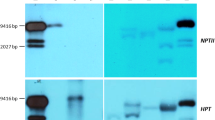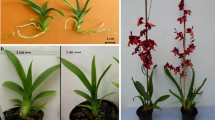Abstract
Oncidium is a popular ornamental orchid and is produced as a high value cash crop for cut flower sold worldwide. Genetically transformed plants of Oncidium were regenerated after cocultivating protocorm-like bodies (PLBs) with Agrobacterium tumefaciens strain LBA4404 harboring pBI121 with OMADS1. The chopped PLBs pre-cultured for 3 days in darkness produced more kanamycin-resistant PLBs. G10 medium containing 200 mg l−1 kanamycin was effective for the selection of transformed lines at a frequency of 9%. The rooted plantlets were transferred to pots, acclimated for 3 weeks in the culture room and then moved to the greenhouse. OMADS1 transgene was detected in transgenic lines by PCR, Southern blot analysis and RT-PCR were performed, and the results confirmed that OMADS1 was expressed in these 35S::OMADS1 transgenic plants. CaMV35S::OMADS1 transgenic Oncidium orchid plants flowered significantly earlier, produced more flowers and pseudobulbs than non-transgenic plants. The flower organ conversions were not observed in 35S::OMADS1 transgenic flowers of Oncidium. This is the first report on the ectopic expression of MADS box gene in O. Gower Ramsey using a simple and efficient gene transfer protocol.





Similar content being viewed by others
References
Arditti J (1992) Fundamentals of orchid biology. John Wiley and Sons, New York, p 691
Belarmino MM, Mii M (2000) Agrobacterium mediated genetic transformation of a Phalaenopsis orchid. Plant Cell Rep 19:435–442
Bradley D, Carpenter R, Sommer H, Hartley N, Coen E (1993) Complementary floral homeotic phenotypes result from opposite orientations of a transposon at the PLENA locus of Antirrhinum. Cell 72:85–95
Carpenter R, Coen ES (1990) Floral homeotic mutations produced by transposon-mutagenesis in Antirrhinum majus. Genes Dev 4:1483–1493
Chai D, Yu H (2007) Recent advances in transgenic orchid production. Orchid Sci Biotechnol 1:34–39
Chai ML, Xu CJ, Senthil KK, Mo SY, Chung YS, Cho SH, Shin JS, Park MH, Kim DW (2002) Stable transformation of protocorm like bodies in Phalaenopsis orchid mediated by Agrobacterium tumefaciens. Sci Hortic 96:213–224
Chandler SF, Lu CY (2005) Biotechnology on ornamental horticulture. In vitro Cell Dev Biol Plant 41:591–601
Chang YY, Chiu YF, Wu JW, Yang CH (2009) Four orchid (Oncidium Gower Ramsey) AP1/AGL9-like MADS box genes show novel expression patterns and cause different effects on floral transition and formation in Arabidopsis thaliana. Plant Cell Physiol 50:1425–1438
Chang YY, Kao NH, Li JY, Hsu WH, Liang YL, Wu JW, Yang CH (2010) Characterization of the Possible Roles for B Class MADS Box Genes in Regulation of Perianth Formation in Orchid. Plant Physiol 152:837–853
De Kathen A, Jacobsen HJ (1990) Agrobacterium tumefaciens-mediated transformation of Pisum sativum L. using binary and cointegrate vectors. Plant Cell Rep 9:276–279
Deroles SC, Boase MR, Lee CE, Peters TA (2002) Gene transfer to plants. In: Vainstein A (ed) Breeding for ornamentals: classical and molecular approaches. Kluwer Academic Publishers, The Netherlands, pp 155–196
Dong JZ, McHughen A (1993) An improved procedure for production of transgenic flax plants using Agrobacterium tumefaciens. Plant Sci 88:66–71
Hsu HF, Huang CH, Chou LH, Yang CH (2003) Ectopic expression of an orchid (Oncidium Gower Ramsey) AGL6-like gene promotes flowering by activating flowering time genes in Arabidopsis thaliana. Plant Cell Physiol 44:783–794
Hsu HF, Hsieh WP, Chen MK, Chang YY, Yang CH (2010) C/D Class MADS-box genes from two monocots orchid (Oncidium Gower Ramsey) and lily (Lilium longiflorum) exhibit different effects on floral transition and formation in Arabidopsis thaliana. Plant Cell Physiol 51:1029–1045
Kang H-G, Noh Y-S, Chung Y–Y, Costa MA, An K, An G (1995) Phenotypic alterations of petal and sepal by ectopic expression of a rice MADS box gene in tobacco. Plant Mol Biol 29:1–10
Kater MM, Colombo L, Franken J, Busscher M, Masiero S, Van Lookeren Campagne MM, Angenent GC et al (1998) Multiple AGAMOUS homologs from cucumber and petunia differ in their ability to induce reproductive organ fate. Plant Cell 10:171–182
Kempin SA, Mandel MA, Yanofsky MF (1993) Conversion of perianth into reproductive organs by ectopic expression of the tobacco floral homeotic gene NAG1. Plant Physiol 103:1041–1046
Liau CH, Lu JC, Prasad V, Lee JT, Hsiao HH, You SJ, Huang HE, Feng TY, Chen WH, Yang NS, Chan MT (2003a) The sweet pepper ferredoxin-like protein (pflp) conferred resistance against soft rot disease in Oncidium orchid. Transgenic Res 12:329–336
Liau CH, You SJ, Prasad V, Hsiao HH, Lu JC, Yang NS, Chan MT (2003b) Agrobacterium tumefaciens-mediated transformation of an Oncidium orchid. Plant Cell Rep 21:993–998
Mishiba K, Chin DP, Mii M (2005) Agrobacterium-mediated transformation of Phalaenopsis by targeting protocorms at an early stage after germination. Plant Cell Rep 24:297–303
Mizukami Y, Ma H (1992) Ectopic expression of the floral homeotic gene AGAMOUS in transgenic Arabidopsis plants alters floral organ identity. Cell 71:119–131
Mizukami Y, Huang H, Tudor M, Hu Y, Ma H (1996) Functional domains of the floral regulator AGAMOUS: characterization of the DNA binding domain and analysis of dominant negative mutations. Plant Cell 8:831–845
Murashige T, Skoog F (1962) A revised medium for rapid growth and bioassays with tobacco tissue cultures. Physiol Plant 15:475–497
Pnueli L, Hareven D, Rounsley SD, Yanofsky MF, Lifschitz E (1994) Isolation of tomato AGAMOUS gene TAG1 and analysis of its homeotic role in transgenic plants. Plant Cell 6:163–173
Rutledge R, Regan S, Nicolas O, Fobert P, Cote C, Bosnich W, Kauffeldt C, Sunohara G, Seguin A, Stewart D (1998) Characterization of an AGAMOUS homologue from the conifer black spruce (Picea mariana) that produces floral homeotic conversions when expressed in Arabidopsis. Plant J 15:625–634
Sambrook J, Fritsch EF, Maniatis T (1989) Molecular cloning: a laboratory manual, 2nd edn. Cold Spring Harbor Laboratory Press, Cold Spring Harbor
Sangwan RS, Bourgeois Y, Brown S, Vansseur G, Sangwan-Norreel B (1992) Characterization of competent cells and early events of Agrobacterium-mediated genetic transformation in Arabidopsis thaliana. Planta 188:439–456
Shrestha BR, Chin DP, Tokuhara K, Mii M (2007) Efficient production of transgenic plantls of Vanda through sonication-assisted Agrobacterium-mediated transformation of protocorm-like bodies. Plant Biotechnol 24:429–434
Tan J, Wang HL, Yeh KW (2005) Analysis of organ-specific, expressed genes in Oncidium orchid by subtractive expressed sequence tags library. Biotechnol Lett 27:1517–1528
Theissen G (2001) Development of floral organ identity: stories from the MADS house. Curr Opin Biol 4:75–85
Theissen G, Saedler H (2001) Floral quartets. Nature 409:469–471
Thiruvengadam M, Yang CH (2009) Ectopic expression of two MADS box genes from orchid (Oncidium Gower Ramsey) and lily (Lilium longiflorum) alters flower transition and formation in Eustoma grandiflorum. Plant Cell Rep 28:1463–1473
Yanofsky MF, Ma H, Bowman JL, Drews GN, Feldmann KA, Meyerowitz EM (1990) The protein encoded by the Arabidopsis homeotic gene agamous resembles transcription factors. Nature 346:35–39
Yee NC, Abdullah JO, Mahmood M, Basiron N (2008) Co-transfer of gfp, CHS and hptII genes into Oncidium Sharry Baby PLB using the biolistic gun. Afr J Biotechnol 7:2605–2617
You SJ, Liau CH, Huang HE, Feng TY, Prasad V, Hsiao HH, Lu JC, Chan MT (2003) Sweet pepper ferredoxin-like protein (pflp) gene as a novel selection marker for orchid transformation. Planta 217:60–65
Yu D, Kotilainen M, Pollanen E, Mehto M, Elomaa P, Helariutta Y, Albert VA, Teeri TH (1999) Organ identity genes and modified patterns of flower development in Gerbera hybrida (Asteraceae). Plant J 17:51–62
Yu H, Yang SH, Goh CJ (2001) Agrobacterium-mediated transformation of a Dendrobium orchid with the class 1 knox gene DOH1. Plant Cell Rep 20:301–305
Acknowledgments
This work was supported by grants to C–H Y from National Science Council, Taiwan, ROC, Grant number: NSC95-2317-B-005-006 and NSC96-2317-B-005-019. This work was also supported by 5Y/50B Grant from the Ministry of Education.
Conflict of interest
The authors declare that they have no conflict of interest.
Author information
Authors and Affiliations
Corresponding authors
Additional information
Communicated by T. Moriguchi.
Rights and permissions
About this article
Cite this article
Thiruvengadam, M., Chung, IM. & Yang, CH. Overexpression of Oncidium MADS box (OMADS1) gene promotes early flowering in transgenic orchid (Oncidium Gower Ramsey). Acta Physiol Plant 34, 1295–1302 (2012). https://doi.org/10.1007/s11738-012-0926-x
Received:
Revised:
Accepted:
Published:
Issue Date:
DOI: https://doi.org/10.1007/s11738-012-0926-x




